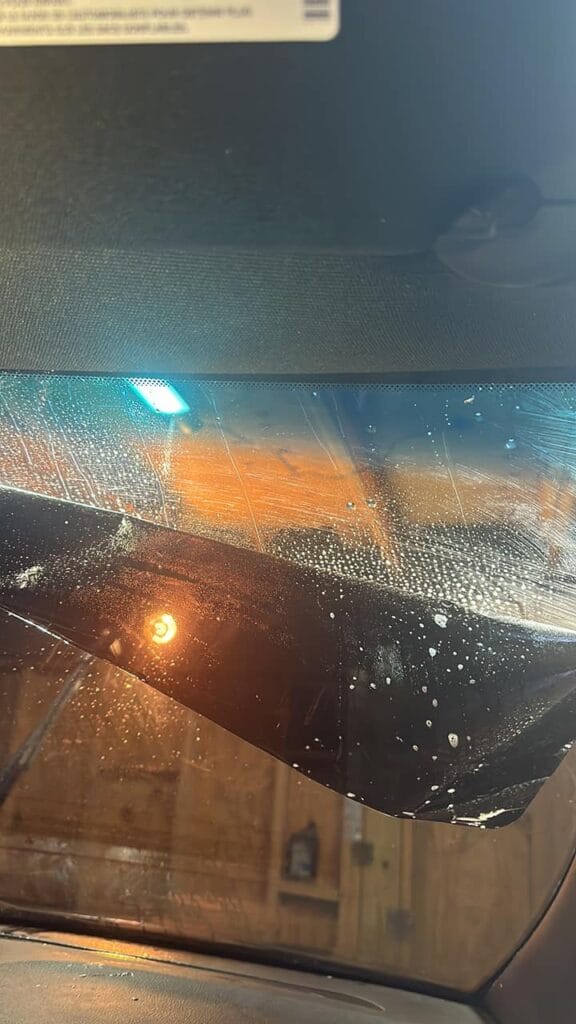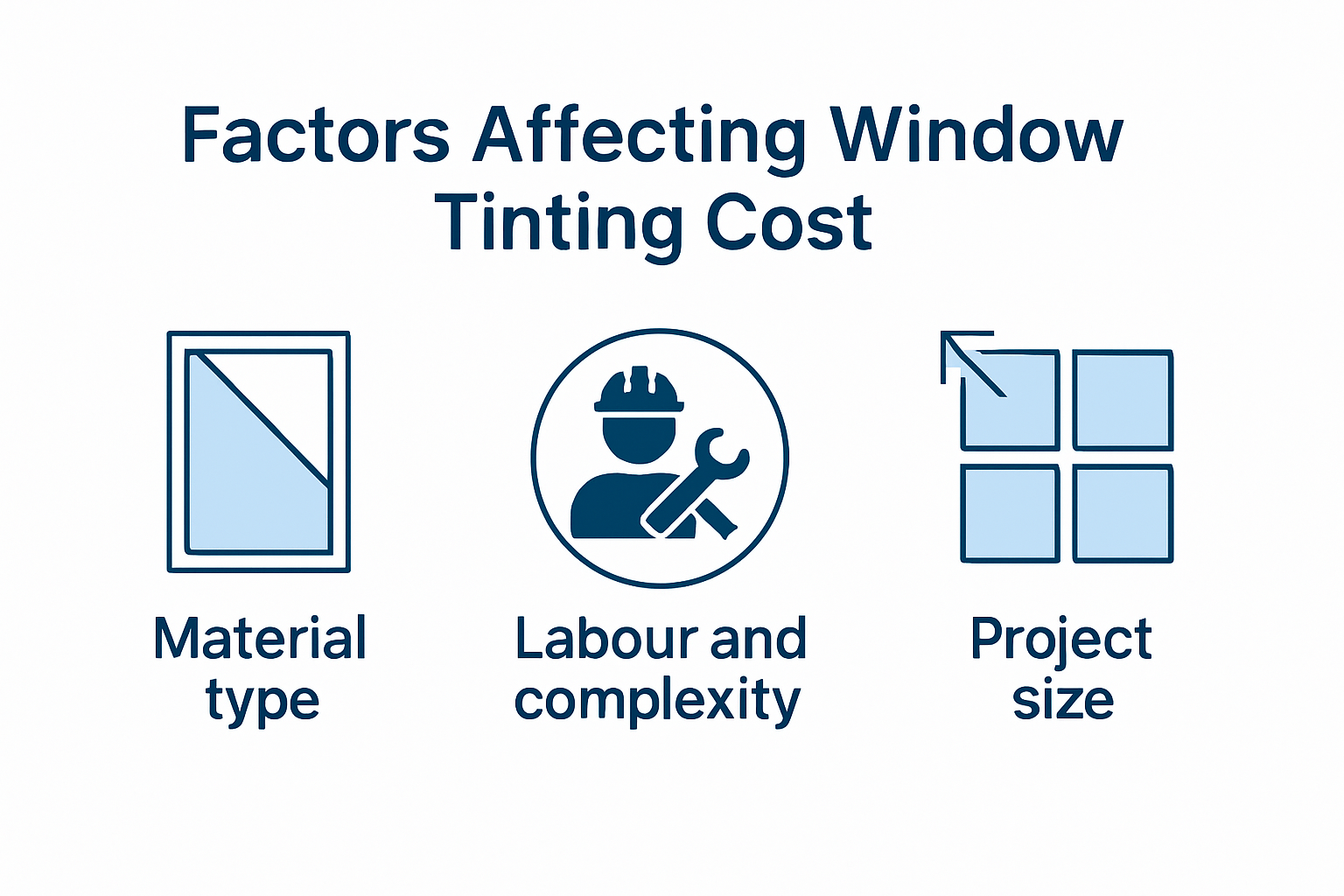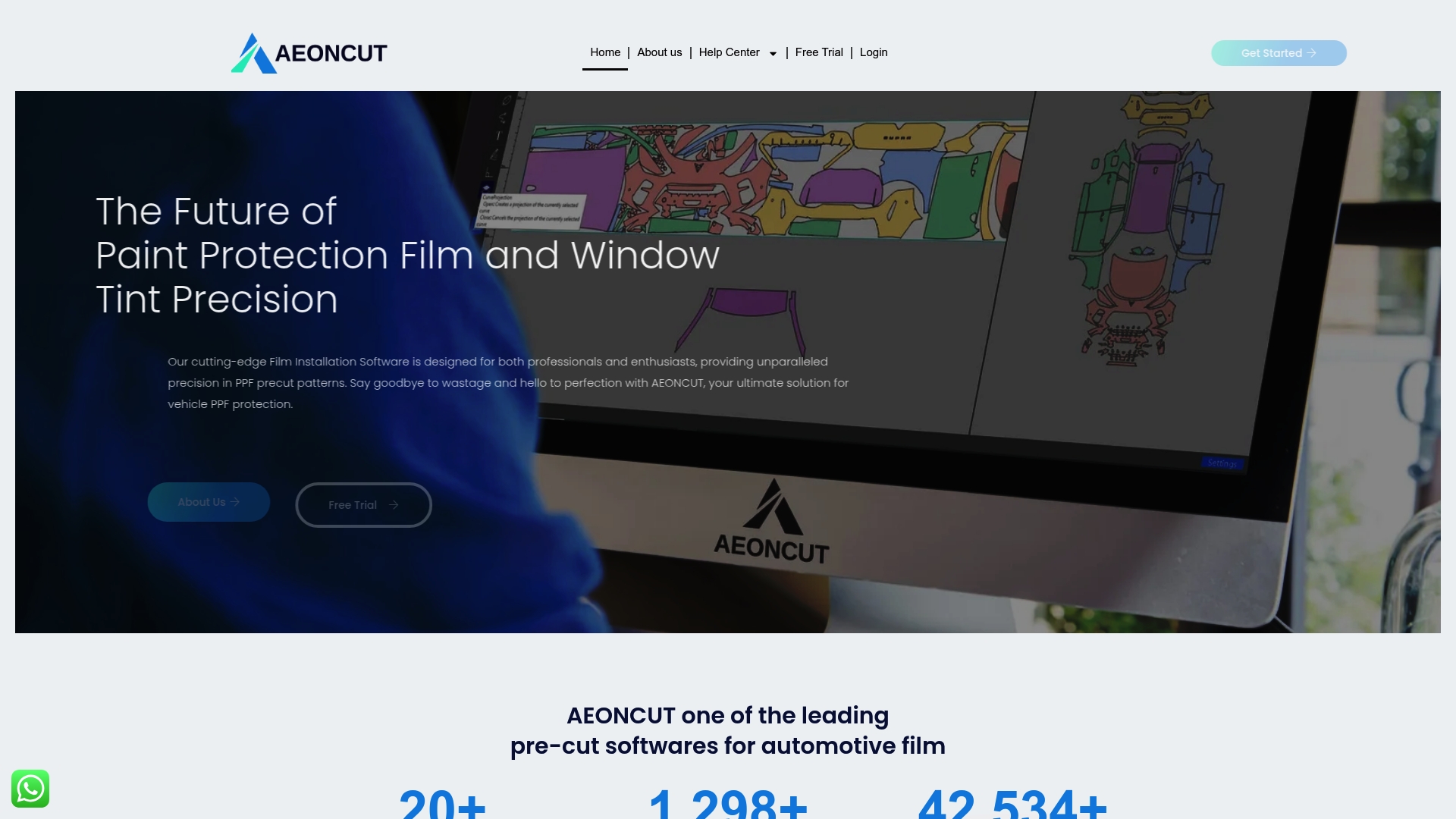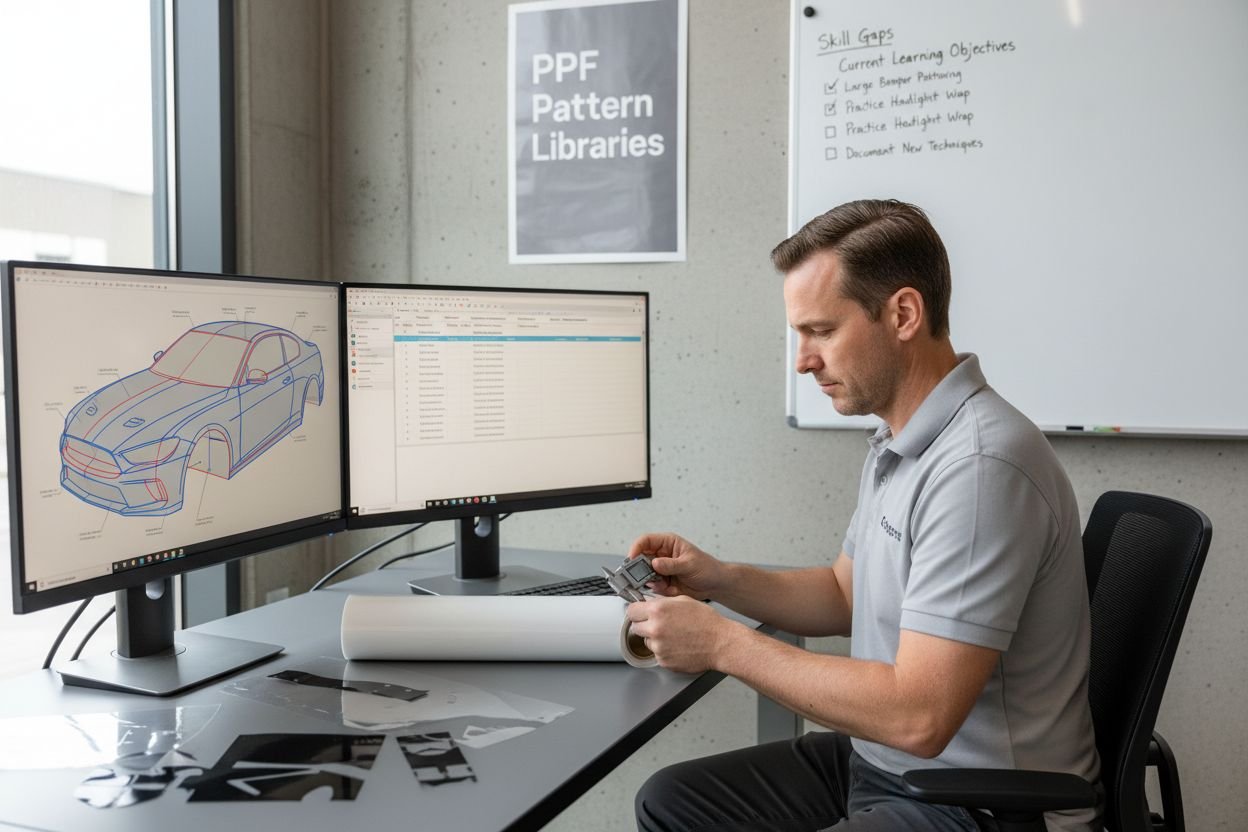
Window tinting prices can leave even seasoned installers scratching their heads. The astonishing part is how much these costs swing, with installation rates ranging from as low as $1 to a steep $12 per square foot just for material choice alone. Most people assume the film is the main cost driver but that is only half the story. Labour complexity, surface size, and even the season can be just as influential, turning a simple job into a surprise bill. Discover what really tips the scales before you quote your next project.
Table of Contents
- Key Factors Affecting Window Tinting Cost
- How Film Types Impact Your Costs
- Typical Costs By Vehicle And Service
- Tips To Maximise Profit And Customer Value
Quick Summary
| Takeaway | Explanation |
|---|---|
| Material quality impacts cost significantly | Different film types, from dyed to ceramic, vary widely in price and performance. Choose wisely based on client needs and budget. |
| Labor costs depend on complexity | Installation can range from $1 to $10 per square foot based on factors like window shape and accessibility. More complex shapes drive up costs. |
| Project size affects overall pricing | Larger projects naturally incur higher costs. Accurate measurements and surface area assessments are crucial for transparent quotes. |
| Consider long-term value of films | Higher upfront costs for premium options can lead to energy savings over time, balancing immediate expenses with long-term benefits. |
| Exceptional service justifies premium pricing | Investing in customer experience through consultations and follow-ups can enhance perceived value and allow for higher service charges. |

Key Factors Affecting Window Tinting Cost
Professional window tinting involves multiple variables that directly impact overall installation costs. Understanding these key factors helps installers provide accurate pricing and set realistic client expectations. Window tinting is not a one size fits all service, and multiple elements contribute to the final price point.
Material Quality and Film Type
The selection of window film dramatically influences installation costs. Different film technologies offer varying performance characteristics and price ranges. Explore detailed film types for comprehensive understanding.
According to Forbes Home Improvement, film types range significantly in pricing:
- Dyed Films: Most affordable option, costing $2 to $4 per square foot
- Ceramic Films: Premium option providing superior heat rejection, ranging from $8 to $12 per square foot
- Metallic Films: Mid range pricing with enhanced durability
Each film type presents unique performance metrics. Ceramic films, while more expensive, offer superior UV protection and heat reduction. Installers must consider client needs and budget constraints when recommending specific film technologies.
Here is a comparison of common window film types, their price ranges, and performance features to help you select the best option for each installation:
| Film Type | Price Range (per sq. ft.) | Heat & UV Protection | Durability |
|---|---|---|---|
| Dyed | $2 – $4 | Basic | Standard |
| Metallic | Mid-range | Moderate | Enhanced |
| Carbon | N/A | Superior | Improved |
| Ceramic | $8 – $12 | Exceptional | Premium |
Installation Complexity and Labor Costs
Labor represents a substantial component of window tinting expenses. Tahoe Solar Film highlights that installation costs typically range from $1 to $10 per square foot, contingent upon several critical factors:
- Window shape and architectural complexity
- Total surface area requiring treatment
- Accessibility of installation location
- Required preparation and surface cleaning
Professional installers must account for additional time and skill needed when dealing with non standard window configurations. Curved surfaces, architectural glass, and intricate building designs require more sophisticated techniques, directly impacting labor expenses.

Project Scale and Surface Measurements
The overall project size significantly influences total window tinting costs. Climate Pro emphasizes that larger projects with multiple windows will naturally incur higher installation expenses.
Key considerations include:
- Total square footage of windows
- Number of individual windows
- Building type (residential versus commercial)
- Special equipment requirements for high or challenging installations
Installers should develop comprehensive measurement protocols to accurately estimate project costs. Precise surface area calculations combined with an understanding of material and labor expenses enable transparent pricing strategies.
By meticulously evaluating these interconnected factors, professional window tint installers can develop accurate cost estimates that reflect the complexity and quality of their services.
How Film Types Impact Your Costs
Window film technology represents a complex intersection of material science, energy efficiency, and cost management for professional installers. Understanding how different film types influence pricing requires a nuanced approach that considers performance, durability, and long term value.
Performance Characteristics and Cost Considerations
Window films are not merely decorative additions but sophisticated technologies designed to manage thermal transfer, UV protection, and aesthetic requirements. Explore advanced film technologies to understand the intricate relationship between film type and cost.
Research published in the Applied Sciences journal traces the evolution of window films from basic radiation blocking technologies in the 1960s to modern high performance solutions. Early films often compromised visibility and increased energy consumption, whereas contemporary options offer refined thermal and optical properties.
Modern window films can be categorized into several primary types:
- Dyed Films: Entry level option with basic heat reduction
- Metallic Films: Enhanced durability with moderate heat rejection
- Carbon Films: Superior heat management with improved aesthetic qualities
- Ceramic Films: Premium performance with exceptional thermal and UV protection
Advanced Film Layering Strategies
Engineering research reveals innovative approaches to optimizing film performance while managing costs. According to a study in the Engineering and Technology Horizons journal, multi layered film configurations can provide cost effective thermal resistance strategies.
The research demonstrated that combining different film types strategically could achieve performance levels comparable to more expensive single layer ceramic films. Specifically, a double layer approach using dyed and carbon films achieved a thermal resistance of 9.46C/W, presenting a more economical alternative to premium ceramic options.
The following table summarises advanced film layering strategies and their effects on performance and cost efficiency, as discussed in engineering research:
| Film Strategy | Description | Thermal Resistance | Cost Efficiency |
|---|---|---|---|
| Single-layer Ceramic | Premium ceramic film only | High | Expensive |
| Double-layer Dyed + Carbon | Dyed base covered by carbon layer | 9.46 C/W | More economical |
| Standard Dyed/Metallic | Simple, single basic film | Basic | Most affordable |
Energy Efficiency and Long Term Value
Beyond immediate installation costs, professional installers must consider the long term economic implications of film selection. A sustainability study examining Low-E window films revealed significant energy consumption reductions:
- 3% reduction in heating energy
- 20% reduction in cooling energy
- Overall 2.7% total energy consumption decrease
While Low-E films represented a higher upfront investment at approximately 135 GBP per square meter compared to 122 GBP for standard solar control films, the potential energy savings make them an attractive long term solution.
Professional installers must balance immediate material costs with potential client benefits. The most expensive film is not always the most appropriate choice. Factors such as building orientation, local climate, client budget, and specific performance requirements all play crucial roles in film selection.
By understanding the nuanced relationship between film types, performance characteristics, and associated costs, installers can provide tailored recommendations that maximize value for their clients while maintaining competitive pricing strategies.
Typical Costs by Vehicle and Service
Professional window tinting services require precise pricing strategies that account for vehicle specifics, film quality, and installation complexity. Understanding the nuanced cost structure helps installers provide transparent and competitive quotes.
Cost Ranges by Vehicle Type
Vehicle size and configuration significantly influence window tinting expenses. Explore vehicle-specific tinting strategies to optimize your pricing model.
According to Cost Helper, typical window tinting costs vary dramatically across vehicle categories:
- Passenger Cars: $100 to $600
- Pickup Trucks: $50 to $500
- SUVs and Minivans: $200 to $800
These price ranges reflect variations in window surface area, glass complexity, and the number of windows requiring treatment. Vehicles with curved or steep rear windows demand more intricate installation techniques, directly impacting labor costs.
The table below compares typical window tinting price ranges by vehicle type, helping installers estimate service costs more efficiently:
| Vehicle Type | Typical Cost Range |
|---|---|
| Passenger Car | $100 – $600 |
| Pickup Truck | $50 – $500 |
| SUV or Minivan | $200 – $800 |
Regional and Seasonal Pricing Dynamics
Summer Breeze Ceramic Coating highlights the significant impact of regional factors on window tinting pricing. Urban areas with higher labor rates can see price variations up to 25% compared to smaller markets.
Key regional pricing considerations include:
- Local labor rate variations
- Competition density among installers
- Seasonal demand fluctuations
Interestingly, summer months can trigger price increases of 10 to 15% due to heightened demand for reflective and infrared blocking films. Urban centers typically command higher installation charges, with average costs ranging from $300 to $600 for a standard sedan.
Service Volume and Competitive Pricing
Yelp’s comprehensive analysis of 463,691 professional quotes reveals critical insights into window tinting pricing strategies. The average service cost stands at $195, with a typical range spanning $85 to $335.
Factors influencing final pricing include:
- Vehicle make and model
- Total number of windows
- Complexity of installation
- Selected film technology
- Geographic location
Professional installers must develop flexible pricing models that account for these variables. While entry level dyed films offer more affordable options, premium ceramic or carbon films command higher rates due to superior performance characteristics.
Successful window tinting businesses recognize that pricing is not merely about covering material and labor costs. It involves creating value propositions that demonstrate the long term benefits of quality window film installation. By understanding these intricate pricing dynamics, installers can develop competitive strategies that attract and retain customers while maintaining healthy profit margins.
Tips to Maximise Profit and Customer Value
Successful window tinting businesses understand that profitability extends beyond simple pricing strategies. Integrating comprehensive approaches that balance technical expertise, customer experience, and strategic marketing can significantly enhance business performance.
Competitive Pricing and Value Proposition
Explore advanced business strategies to elevate your window tinting services. According to ServGrow, developing an effective pricing strategy requires thorough market research and understanding local competitive dynamics.
Key competitive pricing considerations include:
- Researching local market rates
- Analyzing competitors’ service offerings
- Highlighting unique service value
- Balancing affordability with quality
Professional installers must position their services strategically. This means offering transparent pricing that reflects the quality of materials, expertise, and additional value provided beyond basic installation.
Enhancing Customer Service Experience
Tint Wiz emphasizes that customer service often matters more than price. In todays competitive market, exceptional customer interactions can differentiate your business and justify premium pricing.
Strategies to elevate customer experience:
- Provide detailed consultations
- Offer comprehensive warranties
- Deliver transparent communication
- Follow up after service completion
- Create personalised recommendations
Customers are increasingly willing to pay more for superior service. By transforming window tinting from a transactional service to a consultative experience, businesses can command higher prices and build lasting customer relationships.
Strategic Business Networking
Detailers Roadmap highlights the immense potential of strategic business partnerships. Networking with complementary businesses can generate consistent referral streams and expand market reach.
Effective networking approaches include:
- Partnering with car dealerships
- Collaborating with auto detailing shops
- Establishing relationships with auto body repair centers
- Creating co-branded promotional events
- Sharing referral incentives
These partnerships not only provide additional revenue channels but also enhance business credibility. By positioning your window tinting service as an integral part of the automotive customization ecosystem, you create multiple value generation opportunities.
Successful window tinting businesses recognize that profitability is a multifaceted concept. It requires a holistic approach combining technical excellence, customer-centric service, competitive pricing, and strategic networking. Installers who master these elements can transform their services from commodity offerings to premium, sought-after solutions that command higher market values.
Frequently Asked Questions
What are the main factors that affect the cost of window tinting?
The cost of window tinting can vary significantly based on material quality and film type, installation complexity and labour costs, and the project scale and surface measurements. Each of these factors plays a crucial role in determining the overall pricing.
How much does window tinting typically cost per square foot?
Installation rates for window tinting range from as low as £1 to around £12 per square foot, depending largely on the type of film selected and the complexity of the installation.
What types of window film should I consider for cost efficiency?
Consider different film types including dyed films, which are the most affordable at £2 to £4 per square foot, and ceramic films, which range from £8 to £12 but offer superior performance and energy efficiency.
How can I maximise customer value while pricing my window tinting services?
To enhance customer value, focus on competitive pricing by researching local market rates, providing exceptional customer service, offering warranties, and building strategic business partnerships with related services.
Take Control of Your Window Tinting Costs with AEONCUT Solutions
Struggling with unpredictable window tinting costs, material waste, and time-consuming manual cutting can hold your business back. The window Tint category on AEONCUT ensures you never overestimate a quote due to inaccurate patterns or complex installations. Achieve industry-leading accuracy every time using our extensive pattern libraries and AI-powered auto-nesting to minimise errors and expensive leftovers.

Elevate your quoting confidence today and join a community of professionals who already rely on AEONCUT for easy, precise, and efficient window tint installations. Experience smart pattern selection and streamlined workflow. Take your next step towards precision and profit by exploring our window Tint solutions or visiting AEONCUT to find the right subscription plan for your business.
Recommended
- Types of Window Tint: Guide for Installers and Dealers 2025 – AEONCUT PPF Pre-cut Cutting software
- What is Window Tint? Essential Guide for Tinting Pros 2025 – AEONCUT PPF Pre-cut Cutting software
- window Tint – AEONCUT PPF Pre-cut Cutting software
- Top 5 PPF and Tint Cutting Software for Professionals 2025 – AEONCUT PPF Pre-cut Cutting software
- Shutter Cost Breakdown 2025: | Shutter World
- Choosing Blinds Colors: A Simple Guide for 2025 – Urban Studio Designs



